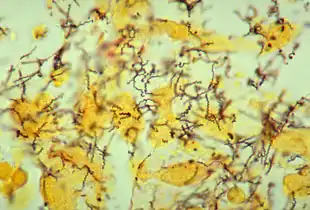Treponemataceae
The Treponemataceae are a family of spirochete bacteria.[4] The clade includes a number of significant pathogens, such as Treponema pallidum, the cause of human syphilis.[5][6]
| Treponemataceae | |
|---|---|
 | |
| Histopathology of Treponema pallidum spirochetes using a modified Steiner silver stain | |
| Scientific classification | |
| Domain: | Bacteria |
| Phylum: | Spirochaetota |
| Class: | Spirochaetia |
| Order: | Spirochaetales |
| Family: | Treponemataceae Robinson 1948[1] (Approved Lists 1980)[2] |
| Genera | |
References
- Robinson GH. (1948). "Family II. Treponemataceae Schaudinn". In Breed RS, Murray EGD, Hitchens AP. (eds.). Bergey's Manual of Determinative Bacteriology (6th ed.). Baltimore, MD: The Williams and Wilkins Co. pp. 1051–1058.
- Skerman VBD, McGowan V, Sneath PHA. (1980). "Approved lists of bacterial names". Int J Syst Bacteriol. 30: 225–420. doi:10.1099/00207713-30-1-225.
- Koelschbach, Janina S.; Mouttaki, Housna; Pickl, Carolin; Heipieper, Hermann J.; Rachel, Reinhard; Lawson, Paul A.; Meckenstock, Rainer U. (2017). "Rectinema cohabitans gen. nov., sp. nov., a rod-shaped spirochaete isolated from an anaerobic naphthalene-degrading enrichment culture". International Journal of Systematic and Evolutionary Microbiology. 67 (5): 1288–1295. doi:10.1099/ijsem.0.001799. PMID 28100313.
- "Family: Treponemataceae". lpsn.dsmz.de. Retrieved 2022-10-12.
- "Medical Definition of TREPONEMATACEAE". www.merriam-webster.com. Retrieved 2022-10-12.
- "Treponema - an overview | ScienceDirect Topics". www.sciencedirect.com. Retrieved 2022-10-12.
This article is issued from Wikipedia. The text is licensed under Creative Commons - Attribution - Sharealike. Additional terms may apply for the media files.